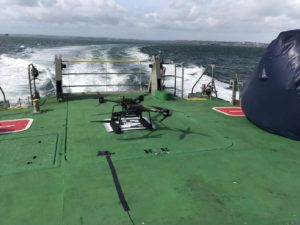
Man-overboard-saving drones tested off Portsmouth

Remote-piloted drones that could locate personnel in the water, drop life-saving equipment and hover over the location until rescuers arrive have been tested by the Royal Navy on Horsea Island and at sea.
Members of the NavyX team – who are the navy’s experimentation experts – are working out how heavy-lift Minerva drones could deliver potentially life-saving equipment if someone falls overboard. Over the past few months, the team tested the drone both at the Royal Navy’s Diving School at Horsea Island, Portsmouth, and more recently on a civilian boat.
First a Minerva T-150 drone was successful in locating a dummy in the water at Horsea Island, deploying a test package that could one day contain a life raft and hovering above the dummy to signpost their location.
The Navy has been trialling numerous new technologies for use on the water, as reported in MIN earlier this year, including crewless boats and the use of drones as deft resupply operators.
With its ability to drop objects, extensively tested with Royal Marines last year in Norway and Cyprus, the Minerva T-150 drone could also deliver a life buoy and other survival equipment.
Following the success at the diving school, sea trials started on an industry boat to test the smaller T-80 Minerva drone. The system was able to be controlled to take off the moving vessel and fly out to sea before returning.
Taking it one step further, the drone was programmed to land itself on a mat attached to the boat’s deck – meaning once it had taken off it would use its on board systems to track where it needed to land.
The work was completed with Defence Equipment and Support (DE&S) and companies Malloy Aeronautics and Planck Aerosystems.
